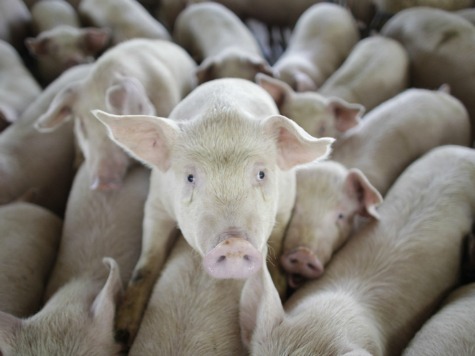
Congress will soon begin consideration of the renewal of the Farm Bill, which has been portrayed by big government politicians and lobbyists as a critical “safety net” for struggling small farmers.
According to the Heritage Foundation, however, much of the legislation’s massive taxpayer-funded agricultural subsidies will be pocketed by wealthy farm owners, including former President Jimmy Carter, U.S. Department of Agriculture (USDA) Secretary Tom Vilsack, and the families of members of Congress currently serving on the House and Senate Agriculture Committees.
Unlike many other industries during the Obama presidency, farming has shown record-high income levels and record-low debt. Yet politicians in largely agricultural states, as well as big agriculture lobbyists, insist that taxpayers struggling in other private sectors fork over their earnings to extremely successful agribusinesses such as Carter’s Farms, Inc. of Plains, Georgia. Data collected by the Environmental Working Group (EWG) shows that the farm owned by former President Jimmy Carter and his family collected $272,288 in subsidy payments from 1995 through 2012.
Diane Katz at the Heritage Foundation reports that during that same period of time, Secretary Vilsack received $82,874 in USDA funds for his 592-acre farm in Davis County, Iowa. His undersecretary, Michael T. Scuse, owns nearly 21 percent of a farm in New Castle County, Delaware that has received $1,051,107 in taxpayer-funded subsidies.
While the island of Manhattan is not prominent in the agriculture business, its residents have collected nearly $9 million in subsidies in the past seven years. Recipients of taxpayer dollars include Mark F. Rockefeller, at $356,018, and David Rockefeller, coming in at $591,057.
Katz reports that farm subsidies have also found their way to celebrities as well. The estate of Jack Benny has collected over $18,000 for a farm in Madera County, California, while former Miss America Mary Ann Mobley was paid $142,933 for a farm in Madison County, Mississippi.
Katz explains that these recipients of taxpayer subsidies, and the amounts they receive, are hardly outliers:
These examples are not exceptions but the norm. The USDA’s Economic Research Service reports that two-thirds of the farms with income exceeding $1 million annually received government payments averaging $54,745 in 2011. Meanwhile, just 27 percent of farms with income of less than $100,000 received payments–averaging just $4,420 in 2011.
The top recipient of subsidies in the EWG data base is Riceland Foods, Inc., self-described as “the world’s largest miller and marketer of rice.” It collected $554,343,039 between 1995 and 2012. According to news reports, Riceland reported sales of $1.16 billion during 2011-2012, the fifth consecutive year of billion-plus revenues for the company.
With big farms receiving free-flowing taxpayer funds, the demand for farmland increases, which in turn raises the price of property. Smaller farmers, or those new to agriculture, are priced out or left to compete in specialized markets.
Members of Congress routinely collect taxpayer funds as well in the form of farm bill subsidies. Lynda Lucas, wife of House Agriculture Committee chairman Frank Lucas (R-OK), collected $40,613 in subsidies for their farm in Roger Mills County, Oklahoma. Similarly, the Iowa family farm of Sen. Charles Grassley (R-IA) has been the recipient of $955,192 in taxpayer funding between 1995 and 2012.
Though environmental groups routinely criticize the negative impact of subsidies on land use, specifically that such payments encourage the conversion of natural habitat to cropland, the Nature Conservancy has raked in $4,795,786 in taxpayer subsidies from 1995 to 2012. Likewise, the National Audubon Society accumulated $932,801 in funding during the same period.
According to Katz, the USDA anticipates that net farm income will reach $128.2 billion this year, the highest level in four decades, while farmers’ debt levels have plummeted to historic lows. Clearly, as Katz writes, “agriculture is well insulated against the risks associated with commodity production, including adverse weather and economic fluctuations.”

COMMENTS
Please let us know if you're having issues with commenting.